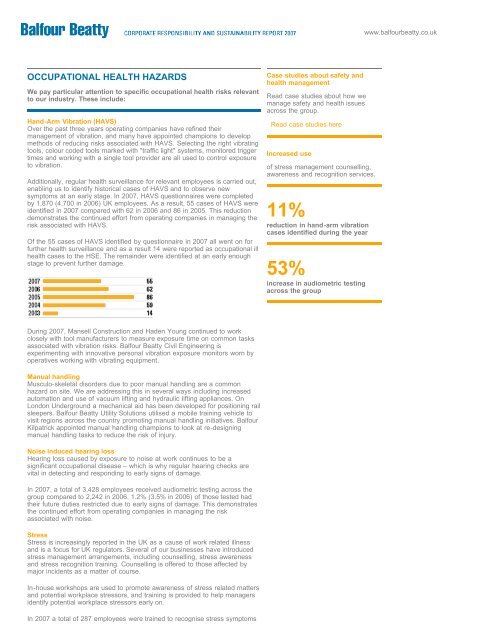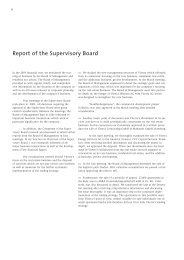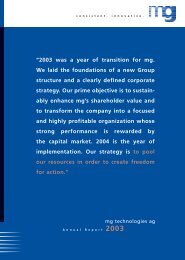Balfour Beatty - Corporate Responsibility Summary Report 2007
Balfour Beatty - Corporate Responsibility Summary Report 2007
Balfour Beatty - Corporate Responsibility Summary Report 2007
You also want an ePaper? Increase the reach of your titles
YUMPU automatically turns print PDFs into web optimized ePapers that Google loves.
www.balfourbeatty.co.uk<br />
OCCUPATIONAL HEALTH HAZARDS<br />
We pay particular attention to specific occupational health risks relevant<br />
to our industry. These include:<br />
Hand-Arm Vibration (HAVS)<br />
Over the past three years operating companies have refined their<br />
management of vibration, and many have appointed champions to develop<br />
methods of reducing risks associated with HAVS. Selecting the right vibrating<br />
tools, colour coded tools marked with "traffic light" systems, monitored trigger<br />
times and working with a single tool provider are all used to control exposure<br />
to vibration.<br />
Additionally, regular health surveillance for relevant employees is carried out,<br />
enabling us to identify historical cases of HAVS and to observe new<br />
symptoms at an early stage. In <strong>2007</strong>, HAVS questionnaires were completed<br />
by 1,870 (4,700 in 2006) UK employees. As a result, 55 cases of HAVS were<br />
identified in <strong>2007</strong> compared with 62 in 2006 and 86 in 2005. This reduction<br />
demonstrates the continued effort from operating companies in managing the<br />
risk associated with HAVS.<br />
Of the 55 cases of HAVS identified by questionnaire in <strong>2007</strong> all went on for<br />
further health surveillance and as a result 14 were reported as occupational ill<br />
health cases to the HSE. The remainder were identified at an early enough<br />
stage to prevent further damage.<br />
Case studies about safety and<br />
health management<br />
Read case studies about how we<br />
manage safety and health issues<br />
across the group.<br />
Read case studies here<br />
Increased use<br />
of stress management counselling,<br />
awareness and recognition services.<br />
11%<br />
reduction in hand-arm vibration<br />
cases identified during the year<br />
53%<br />
increase in audiometric testing<br />
across the group<br />
During <strong>2007</strong>, Mansell Construction and Haden Young continued to work<br />
closely with tool manufacturers to measure exposure time on common tasks<br />
associated with vibration risks. <strong>Balfour</strong> <strong>Beatty</strong> Civil Engineering is<br />
experimenting with innovative personal vibration exposure monitors worn by<br />
operatives working with vibrating equipment.<br />
Manual handling<br />
Musculo-skeletal disorders due to poor manual handling are a common<br />
hazard on site. We are addressing this in several ways including increased<br />
automation and use of vacuum lifting and hydraulic lifting appliances. On<br />
London Underground a mechanical aid has been developed for positioning rail<br />
sleepers. <strong>Balfour</strong> <strong>Beatty</strong> Utility Solutions utilised a mobile training vehicle to<br />
visit regions across the country promoting manual handling initiatives. <strong>Balfour</strong><br />
Kilpatrick appointed manual handling champions to look at re-designing<br />
manual handling tasks to reduce the risk of injury.<br />
Noise induced hearing loss<br />
Hearing loss caused by exposure to noise at work continues to be a<br />
significant occupational disease – which is why regular hearing checks are<br />
vital in detecting and responding to early signs of damage.<br />
In <strong>2007</strong>, a total of 3,428 employees received audiometric testing across the<br />
group compared to 2,242 in 2006. 1.2% (3.5% in 2006) of those tested had<br />
their future duties restricted due to early signs of damage. This demonstrates<br />
the continued effort from operating companies in managing the risk<br />
associated with noise.<br />
Stress<br />
Stress is increasingly reported in the UK as a cause of work related illness<br />
and is a focus for UK regulators. Several of our businesses have introduced<br />
stress management arrangements, including counselling, stress awareness<br />
and stress recognition training. Counselling is offered to those affected by<br />
major incidents as a matter of course.<br />
In-house workshops are used to promote awareness of stress related matters<br />
and potential workplace stressors, and training is provided to help managers<br />
identify potential workplace stressors early on.<br />
In <strong>2007</strong> a total of 287 employees were trained to recognise stress symptoms









